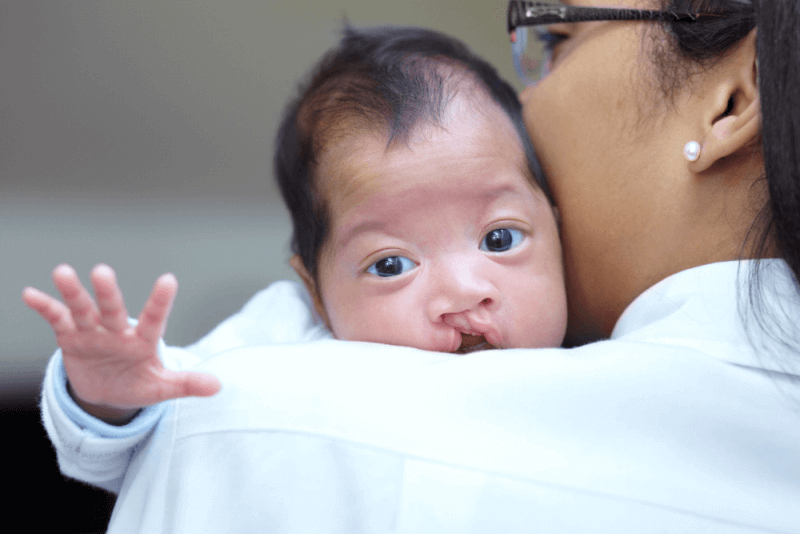What is Cleft Lip?
Cleft lip refers to facial and oral differences that occur during the very early stages of fetal development. The failure of tissues in the lip area to merge due to insufficient tissue leads to the formation of a cleft.
A cleft lip is the physical separation of the two sides of the upper lip or a narrow opening or gap in the skin of the upper lip. This cleft usually extends beyond the base of the nose and may include the upper jaw or upper gum bones.
A cleft lip can develop on one or both sides of the mouth. Since the lip and palate develop separately, it is possible for a cleft lip and cleft palate to occur together.
Cleft Lip Diagnosis Methods
Most cleft lips can be detected through ultrasound imaging during pregnancy check-ups, as these clefts cause visible physical changes in the fetus's face. Isolated cleft palates are more challenging to detect via ultrasound.
If no cleft is detected in the ultrasound images before birth, a physical examination of the mouth, nose, and palate after birth is usually sufficient to diagnose a cleft lip. In some cases, specialists may recommend tests to check for genetic conditions associated with cleft lip.
The formation of the fetus's lip is completed between the 4th and 7th weeks of pregnancy. Therefore, cleft lip can be detected as early as the 20th week of pregnancy. In some cases, cleft lip can be diagnosed as early as the 12th week.
Causes of Cleft Lip
The exact cause of cleft lip is not yet fully understood. Scientists believe that cleft lip usually occurs due to a combination of genetic and environmental factors. Therefore, if a parent, sibling, or another relative has a cleft lip, there is a higher chance that a newborn may also have a cleft lip.
Additionally, the use of certain medications during pregnancy increases the likelihood of a cleft lip. Other factors that may contribute to cleft lip include:
- Antiseptic medications
- Medications used to treat acne
- Medications used in the treatment of psoriasis, arthritis, and cancer
- Folic acid deficiency
- Maternal obesity
- Use of tobacco products during pregnancy
- Maternal substance use disorder
- Exposure to certain viruses or chemicals during pregnancy
Symptoms of Cleft Lip
A cleft lip is usually immediately noticeable at birth. It is a cleft that affects one or both sides of the face and is visible on the lip. In some cases, the cleft may appear as only a small notch in the lip, while in other cases, it may extend up to the upper gum and base of the nose.
Complications of Cleft Lip
Children born with cleft lips may face various challenges depending on the type and severity of the cleft. These challenges include:
- The most significant concern for babies with cleft lips is the difficulty they may experience in feeding. However, babies born with both a cleft lip and cleft palate are more likely to face feeding problems.
- If the cleft extends into the upper gum, it can affect tooth development.
- Speech development may be affected, as the lips play a significant role in speech.
- The visible differences in appearance caused by a cleft lip can lead to social, emotional, and behavioral issues in children.
Treatment Methods for Cleft Lip
Due to the numerous oral health and medical issues associated with cleft lip, the care of these children is typically managed by a team of pediatricians and other specialists.
The team involved in treating cleft lip usually includes:
- A plastic surgeon to assess the lip and perform necessary surgeries
- An orthodontist to correct and reposition teeth
- A dentist for routine dental care
- A prosthodontist to improve appearance and meet functional needs related to eating and speaking by making prosthetic teeth and dental appliances
- A speech pathologist to assess speech and feeding issues
- A speech therapist to work with the child to improve speech
- A nurse to provide ongoing health monitoring
- A social worker or psychologist to support the family and assess adjustment issues
- A geneticist to help parents understand the risk of having another child with this condition
Cleft Lip Surgery
Surgical procedures are the only option for treating cleft lip. The approach to treatment varies depending on the size of the cleft, the child's age, and other special needs or health conditions. It is performed under general anesthesia.
Methods of Cleft Lip Surgery
Cleft lip surgery is performed between the ages of 3 to 6 months. Although a cleft lip can often be repaired in a single operation, a second surgery may be necessary in some cases. In such cases, the second surgery is performed when the baby is 6 months old.
Before cleft lip surgery, non-invasive techniques can be used to improve the results of lip repair. These procedures significantly alter the shape of the nose. These techniques include:
- Lip taping to narrow the gap in the child's cleft lip
- Nasal elevator technique to help the baby's nose take on a more natural shape
- Nasal alveolar molding device to position the lip tissues more favorably in preparation for surgical lip repair
In surgical cleft lip repair, incisions are made on either side of the cleft to create flaps of tissue. These flaps are then stitched together, including the lip muscles, to form a more typical lip appearance and function. If necessary, the initial nasal repair is performed during the first surgery.
Side Effects of Cleft Lip Surgery
The side effects that may occur during and after cleft lip surgery include:
- Allergic reactions to the sutures, adhesives, injectables, or topical preparations used during or after surgery
- Anesthesia risks
- Bleeding
- Damage to deeper structures such as nerves, blood vessels, and muscles
- Infection
- Irregular healing of scars
- Poor wound healing
- The possibility of revision surgery
- Residual asymmetries or irregularities in the lip or nose
- Post-operative breathing problems
Benefits of Cleft Lip Surgery
The benefits of surgically treating a cleft lip in infants include:
- Improved feeding abilities in babies
- Enhanced speech and hearing abilities in children
- A more typical appearance for children following restoration
Life After Cleft Lip Surgery
After the recovery process following cleft lip surgery, children generally achieve a normal appearance and regain normal eating and speaking abilities. Once the surgery is successful, children can resume their normal lives.
Recovery Process for Cleft Lip
After cleft lip surgery, a liquid or pureed diet is generally recommended. Babies are also advised to avoid pacifiers, bottles, straws, or other utensils for a few days. Arm restraints are typically used to prevent the baby from touching or injuring the surgical area while healing.
Some surgeons may allow these restrictions to be lifted if the child is closely supervised and prevented from touching the surgical site or sucking on their fingers.
Pain relief medications can be used to manage discomfort. Depending on the surgical technique used, the stitches in the lip may need to be removed after surgery. Swelling decreases over a few weeks as healing progresses. Lip scars will fade within a few months. It is essential to protect the lip from sun exposure to prevent irregular scarring after surgery.
Precautions for Cleft Lip Patients
Proper nutrition is crucial for babies born with a cleft lip. These babies often have weaker jaw strength, leading to reduced growth and nutrition. Therefore, special bottles should be used.
It is also recommended that parents seek support from an experienced feeding therapist or lactation consultant for feeding cleft-lip babies. In most cases, however, feeding precautions are generally unnecessary.







